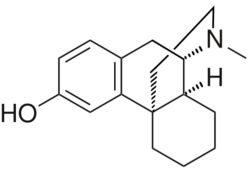Chemistry:Dextrorphan
 | |
 | |
| Clinical data | |
|---|---|
| Other names | DXO, Dextrorphanol |
| ATC code |
|
| Legal status | |
| Legal status |
|
| Identifiers | |
| |
| CAS Number |
|
| PubChem CID | |
| ChemSpider |
|
| UNII | |
| ChEMBL | |
| Chemical and physical data | |
| Formula | C17H23NO |
| Molar mass | 257.377 g·mol−1 |
| 3D model (JSmol) | |
| |
| |
| | |
Dextrorphan (DXO) is a psychoactive drug of the morphinan class which acts as an antitussive or cough suppressant and dissociative hallucinogen. It is the dextrorotatory enantiomer of racemorphan; the levorotatory enantiomer is levorphanol. Dextrorphan is produced by O-demethylation of dextromethorphan by CYP2D6. Dextrorphan is an NMDA antagonist and contributes to the psychoactive effects of dextromethorphan.[2]
Contents
Pharmacology
Pharmacodynamics
| Site | Ki (nM) | Species | Ref |
|---|---|---|---|
| NMDAR (MK-801) |
486–906 | Rat | [3] |
| σ1 | 118–481 | Rat | [3] |
| σ2 | 11,325–15,582 | Rat | [3] |
| DOR | 34,700 | Rat | [3] |
| KOR | 5,950 | Rat | [3] |
| SERT | 401–484 | Rat | [3] |
| NET | ≥340 | Rat | [3] |
| DAT | >1,000 | Rat | [3] |
| 5-HT1A | >1,000 | Rat | [3] |
| 5-HT1B/1D | 54% at 1 μM | Rat | [3] |
| 5-HT2A | >1,000 | Rat | [3] |
| α1 | >1,000 | Rat | [3] |
| α2 | >1,000 | Rat | [3] |
| β | 35% at 1 μM | Rat | [3] |
| D2 | >1,000 | Rat | [3] |
| H1 | 95% at 1 μM | Rat | [3] |
| mAChRs | 100% at 1 μM | Rat | [3] |
| nAChRs | 1,300–29,600 (IC50) |
Rat | [3] |
| VDSCs | ND | ND | ND |
| Values are Ki (nM), unless otherwise noted. The smaller the value, the more strongly the drug binds to the site. | |||
The pharmacology of dextrorphan is similar to that of dextromethorphan (DXM). However, dextrorphan is much more potent as an NMDA receptor antagonist as well much less active as a serotonin reuptake inhibitor, but retains DXM's activity as a norepinephrine reuptake inhibitor.[4] It also has more affinity for the opioid receptors than dextromethorphan, significantly so at high doses.
Pharmacokinetics
Dextrorphan has a notably longer elimination half-life than its parent compound, and therefore has a tendency to accumulate in the blood after repeated administration of normally dosed dextromethorphan formulations.[citation needed] It is further converted to 3-HM by CYP3A4 or glucuronidated.[5]
Society and culture
Legal status
Dextrorphan was formerly a Schedule I controlled substance in the United States , but was unscheduled on October 1, 1976.[6]
Research
Dextrorphan was under development for the treatment of stroke, and reached phase II clinical trials for this indication, but development was discontinued.[7]
Environmental presence
In 2021, dextrorphan was identified in >75% of sludge samples taken from 12 wastewater treatment plants in California . The same study associated dextrorphan with estrogenic activity by using predictive modelling, before observing it in in vitro. [8]
See also
- Cough syrup
- Racemorphan; Levorphanol
- Noscapine
- Codeine; Pholcodine
- Dextromethorphan; Dimemorfan
- Butamirate
- Pentoxyverine
- Tipepidine
- Cloperastine
- Levocloperastine
References
- ↑ Bensinger, Peter (October 1, 1976). "Dextrophan and Nalbuphine; Removal from Schedules". https://www.govinfo.gov/content/pkg/FR-1976-10-01/pdf/FR-1976-10-01.pdf.
- ↑ "Psychotropic effects of dextromethorphan are altered by the CYP2D6 polymorphism: a pilot study". Journal of Clinical Psychopharmacology 18 (4): 332–337. August 1998. doi:10.1097/00004714-199808000-00014. PMID 9690700.
- ↑ 3.00 3.01 3.02 3.03 3.04 3.05 3.06 3.07 3.08 3.09 3.10 3.11 3.12 3.13 3.14 3.15 3.16 3.17 Cite error: Invalid
<ref>tag; no text was provided for refs namedpmid26826604 - ↑ "Comparison of the effects of dextromethorphan, dextrorphan, and levorphanol on the hypothalamo-pituitary-adrenal axis". The Journal of Pharmacology and Experimental Therapeutics 309 (2): 515–522. May 2004. doi:10.1124/jpet.103.060038. PMID 14742749.
- ↑ "Comparative contribution to dextromethorphan metabolism by cytochrome P450 isoforms in vitro: can dextromethorphan be used as a dual probe for both CTP2D6 and CYP3A activities?". Drug Metabolism and Disposition 29 (11): 1514–20. November 2001. PMID 11602530. http://dmd.aspetjournals.org/cgi/pmidlookup?view=long&pmid=11602530.
- ↑ DEA. "Lists of: Scheduling Actions Controlled Substances Regulated Chemicals". http://www.deadiversion.usdoj.gov/schedules/orangebook/orangebook.pdf.
- ↑ "Dextrorphan - AdisInsight". http://adisinsight.springer.com/drugs/800009336.
- ↑ "Using Estrogenic Activity and Nontargeted Chemical Analysis to Identify Contaminants in Sewage Sludge". Environmental Science & Technology 55 (10): 6729–6739. May 2021. doi:10.1021/acs.est.0c07846. PMID 33909413. Bibcode: 2021EnST...55.6729B.
| Expectorants | |
|---|---|
| Mucolytics | |
| Cough suppressants | |
| |
| |||||||||||||||||||||||||||||||||||||||||||||||||||||||||||||||||||||||||||||||||||||||||||||||||
 | 0.00      (0 votes) (0 votes) |
